
Rokeya Sakhawat Hossain, commonly known as Begum Rokeya, was a prominent Bengali feminist thinker, writer, educator and political activist from British India. She is widely regarded as a pioneer of women's liberation in Bangladesh and India.
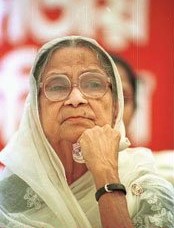
Begum Sufia Kamal was a Bangladeshi poet, feminist leader, and political activist. She took part in the Bengali nationalist movement of the 1950s and civil society leader in independent Bangladesh. She led feminist activism and was a president of Bangladesh Mahila Parishad. She died in 1999 and was the first woman to be given a state funeral in Bangladesh.

Rangpur, is a metropolitan city and a major city in northern Bangladesh. This city serves as the administrative center of the Rangpur Division. It is strategically located on the banks of the Ghaghot River and near the Teesta River. It is the second largest City Corporation in Bangladesh. The city has developed rapidly in recent years, with improvements in infrastructure and services enhancing its role as a key regional hub. Rangpur has become a key destination for students from other districts and cities seeking quality education. Rangpur City features notable educational institutions. Rangpur has also a vibrant local culture, including traditional festivals and community events.

Rangpur District is a district in Northern Bangladesh. It is a part of the Rangpur Division.
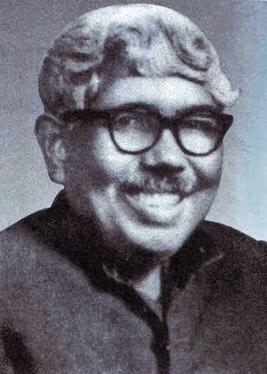
Govinda Chandra Dev, also known as Dr. G. C. Dev, was a professor of philosophy at the University of Dhaka. He was assassinated at the onset of Bangladesh Liberation War of 1971 by the Pakistan Army.
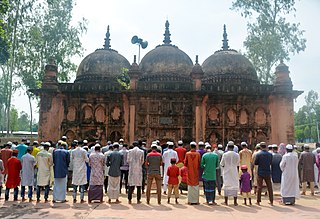
Mithapukur is an upazila of Rangpur District in the division of Rangpur, Bangladesh. The upazila is situated in the middle of Rangpur, surrounded by Rangpur Sadar to the north, Pirganj to the south, Badarganj and Phulbari to the west and Pirgachha and Sundarganj to the east. Mithapukur is famous for being the birthplace of Begum Rokeya and its sweet mango Harivanga.

Pirganj is an upazila of Rangpur District in the division of Rangpur, Bangladesh. Pirganj Upazila area 411.35 km2, located in between 25°18' and 25°31' north latitudes and in between 89°08' and 89°25' east longitudes. It is bounded by Mithapukur Upazila on the north, Palashbari Upazila on the south, Ghoraghat Upazila and Nawabganj Upazila on the west, Sadullapur Upazila on the east.
Shamsunnahar Mahmud was a writer, politician and educator in Bengal during the early 20th century. She was a leader of the women's rights movement in Bengal pioneered by Begum Rokeya. Shamsunnahar Hall of the University of Dhaka and University of Chittagong was named after her.

Tourism in Bangladesh includes tourism to World Heritage Sites, historical monuments, resorts, beaches, picnic spots, forests, tribal people, and wildlife of various species. Activities for tourists include angling, water skiing, river cruising, hiking, rowing, yachting, beachgoing and sea bathing.

Begum Rokeya University, Rangpur, formerly Rangpur University, is a public research university in Rangpur, Bangladesh. Founded in 2008, it is the only generally categorized university in Rangpur Division and the second public university in the region. It was named after the feminist writer and social worker Begum Rokeya.
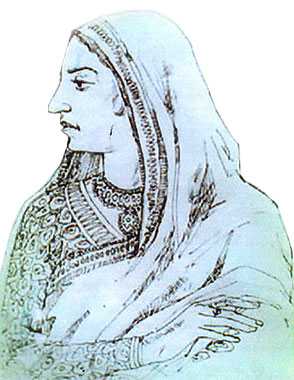
Nawab Begum Faizunnesa Choudhurani was Zamindar of Homnabad-Pashchimgaon Estate in present-day Comilla District, Bangladesh. She is most famous for her campaign for female education and other social issues. In appreciation of her social work, in 1889 Queen Victoria awarded Faizunnesa the title of "Nawab", making her the first female Nawab in South Asia.
Husna Banu Khanam was a Bangladeshi educationist, writer and Nazrul singer. She was a pioneer of Bengali Muslim women journalism. In 1999, she received the Ekushey Padak Award for her contribution in music, and in 2004, she received the Begum Rokeya Medal for her contribution to the socio-economic development of women by the Government of Bangladesh.
Karimunnesa Khanam Chaudhurani was a Bengali poet, social worker, and patron of literature.
Md. Hasibur Rashid is a Bangladeshi educationist and professor in the Department of Management Information Systems, Dhaka University and Head of Department of MIS, Begum Rokeya University. He was the fifth Vice-Chancellor of Begum Rokeya University, Rangpur (BRUR). Prior to this position he was the second treasurer of the University.
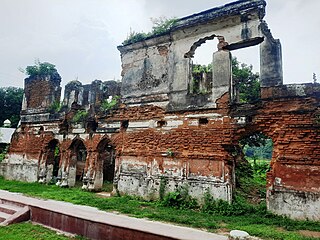
The Azim Choudhury Zamindar Bari is a historic estate and Bengali family based in the village of Dulai in Sujanagar, Pabna District.

The zamindars of Mahipur were a Bengali aristocratic family of feudal landowners. The zamindari estate encompassed the Chakla of Qazirhat under the Cooch Behar State since the Mughal period. Although their aristocratic status was lost with the East Bengal State Acquisition and Tenancy Act of 1950, the Mahipur estate remains an important part of the history of Rangpur and belongs to one of the eighteen ancient zamindar families of Rangpur. The zamindari palace was lost as a result of flooding from the Teesta River, although the mosque, cemetery, polished reservoir and large draw-well can still be seen today.

The Gunahar Zamindar Bari was a zamindari estate based in the Bogra District of Bangladesh. The residential palace, popularly known as Saheb Bari, was the erstwhile Zamindars of Gunahar in Dhupchanchia. The present building was constructed in 1941, and remains a tourist attraction.

Abu Sayed was a Bangladeshi student activist who was shot dead by the Bangladesh Police on 16 July 2024, while participating in the 2024 Bangladesh quota reform movement. Sayed was a student of Begum Rokeya University and was involved in the protest in front of the university when the police engaged in lathi charges and opened fire on the students.

Mekurtari Shahi Mosque is a three-domed mosque located in Bangladesh's Kurigram District. It was built during the Mughal period. The country's Department of Archaeology has designated it as a protected monument.

Ancient Begum Rokeya Mosque is a historical site. It is believed to have been built in the 18th century. This mosque is listed as an archaeological structure by the Department of Archaeology (Bangladesh). However, the mosque has now been rebuilt. The mosque is located in front of the Begum Rokeya Memorial Center. If anyone wants to see the ancient mosque, they will be unable to as only a few parts of the ancient mosque remain, hidden from public view.



























